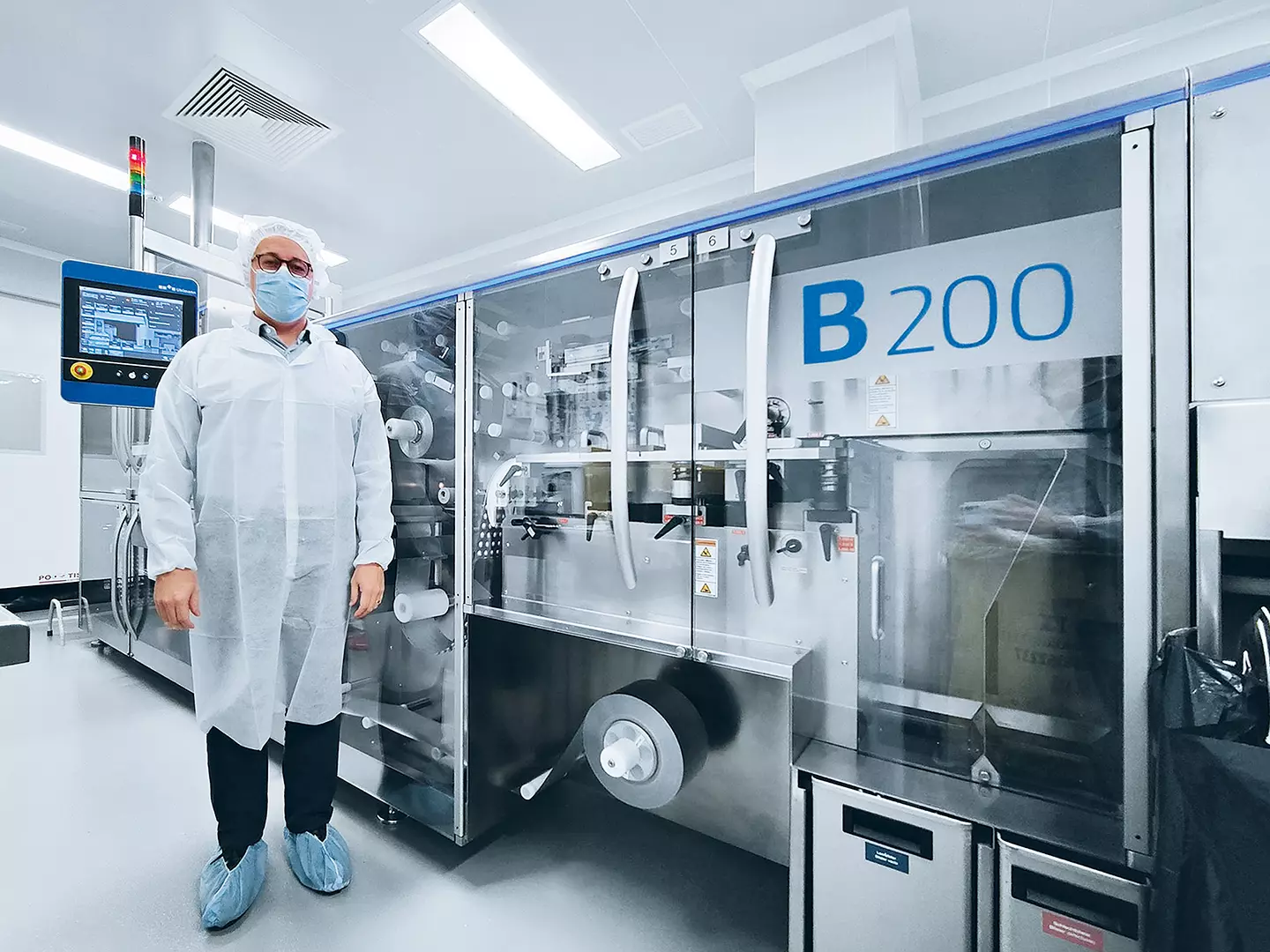
Synthon develops, produces and packages active ingredients, high-quality generics medicines for over 100 countries. The variety of dosages, package sizes, regional variants and special features such as wallet packaging continues to increase. The result: steadily decreasing batch sizes.
“We have been dealing with the trend toward smaller batches for a long time, both for packaged pharmaceuticals and bulk goods,” reports Albert Vallverdú, Manufacturing Director at Synthon Hispania. „In pharma packaging, we initially successfully optimized our format changeover process and production schedules. But at some point, that wasn’t enough to really produce efficiently.“
Those responsible asked themselves how a higher output could be achieved on the existing lines? How can a highly efficient system be designed for packaging small batches that is easy to operate and clean?
Blister line BEC 200 with customized blister transfer
Synthon decided to install an additional pharmaceutical packaging line specifically for small batches. For this, the project team identified three technical requirements:
1. The blister transfer from the blister machine to the cartoner would need to be particularly flexible.
2. Format changes would need to be quick and easy.
3. The ability to use as many format parts as possible from the two existing BEC 300 blister lines.
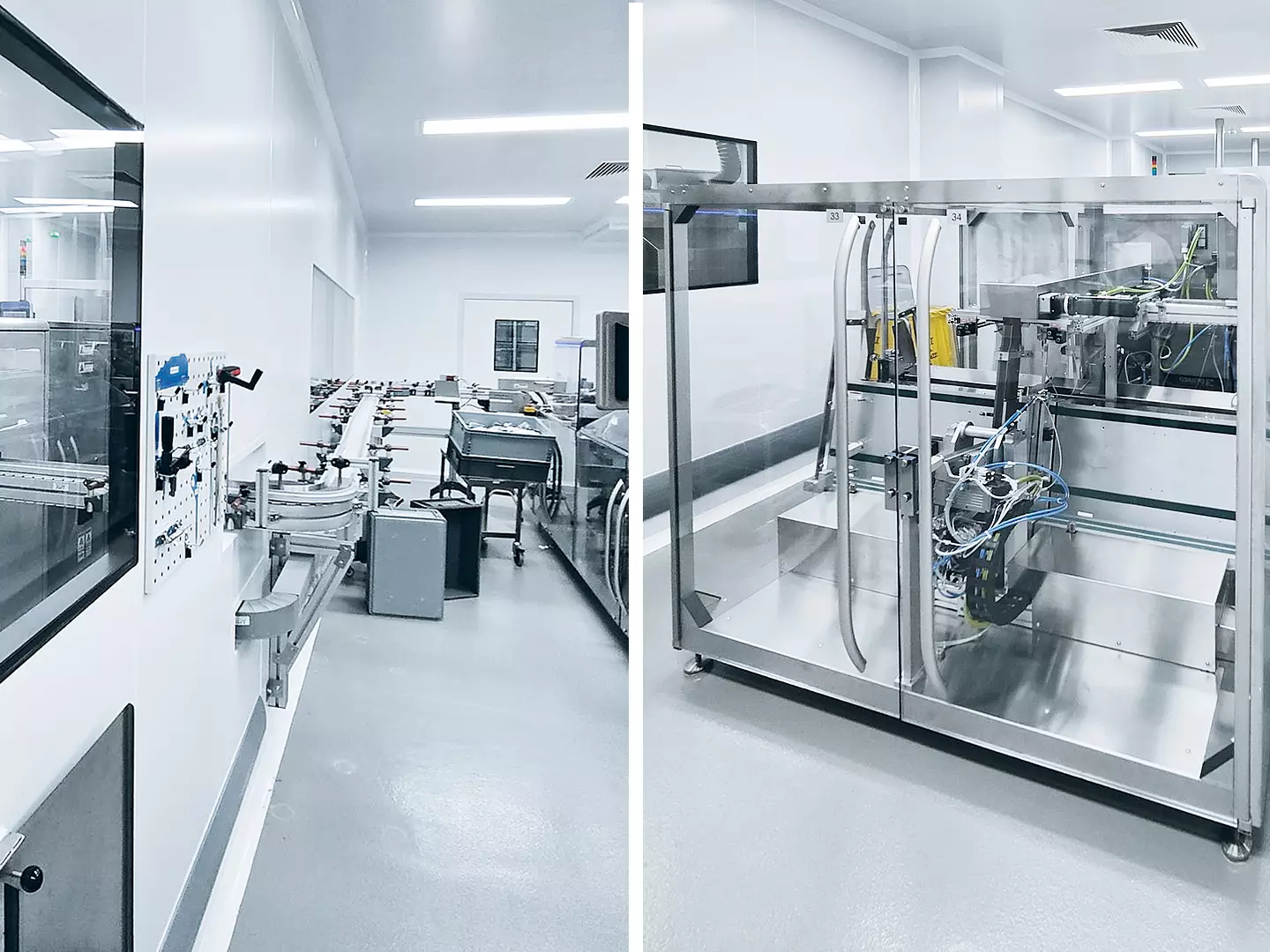
Subsequently, a system was implemented together with Uhlmann that goes far beyond the line itself. It includes production planning, batch management, process optimization as well as training:
- Those responsible opted for a new BEC 200 blister line from Uhlmann which, with its fast format changes of less than 30 minutes, is ideally suited to small batches.
- As far as possible, all “small orders” are bundled on this line so that the other packaging machines can be efficiently utilized with medium and large batches.
- In addition, Synthon and Uhlmann jointly developed a special blister transfer system: the sealed blisters are either seamlessly transferred to the cartoner or temporarily stored in trays. The cartoner is able to transfer the blisters both directly from the blister machine and from the trays.
- This provides Synthon with the opportunity to produce a larger quantity of identical blisters, which can then be boxed in smaller portions for different markets.
75 batches a month on one line
The advantages are obvious: due to the fast format changes, the productivity of the BEC 200 is relatively high despite many small batches. At the same time, OEE on the other packaging lines increases because fewer product changes are necessary. If required, blister packaging and cartoning can be planned independently of each other – for increased flexibility. Existing format parts from the BEC 300 lines can also be shared to some extent. And operation and maintenance were almost routine for the team due to the similar design.
The BEC 200 has been running at the Synthon plant in Sant Boi, Spain, since September 2021 – and with 75 batches being packed on the new BEC 200 per month, the figures show that the concept is working. This means that the daily average in three-shift operation from Monday to Friday is 3.75 batches per day – that’s quite something! At the same time, the average batch size on the previous lines was not affected and productivity was maintained.
But Synthon would not be Synthon if those responsible were satisfied with this improvement. The next step is to further optimize the workflows in order to increase efficiency even more. For the future, the company expects the trend to continue – towards an increasingly complex packaging process, including micro batches and even more variants.
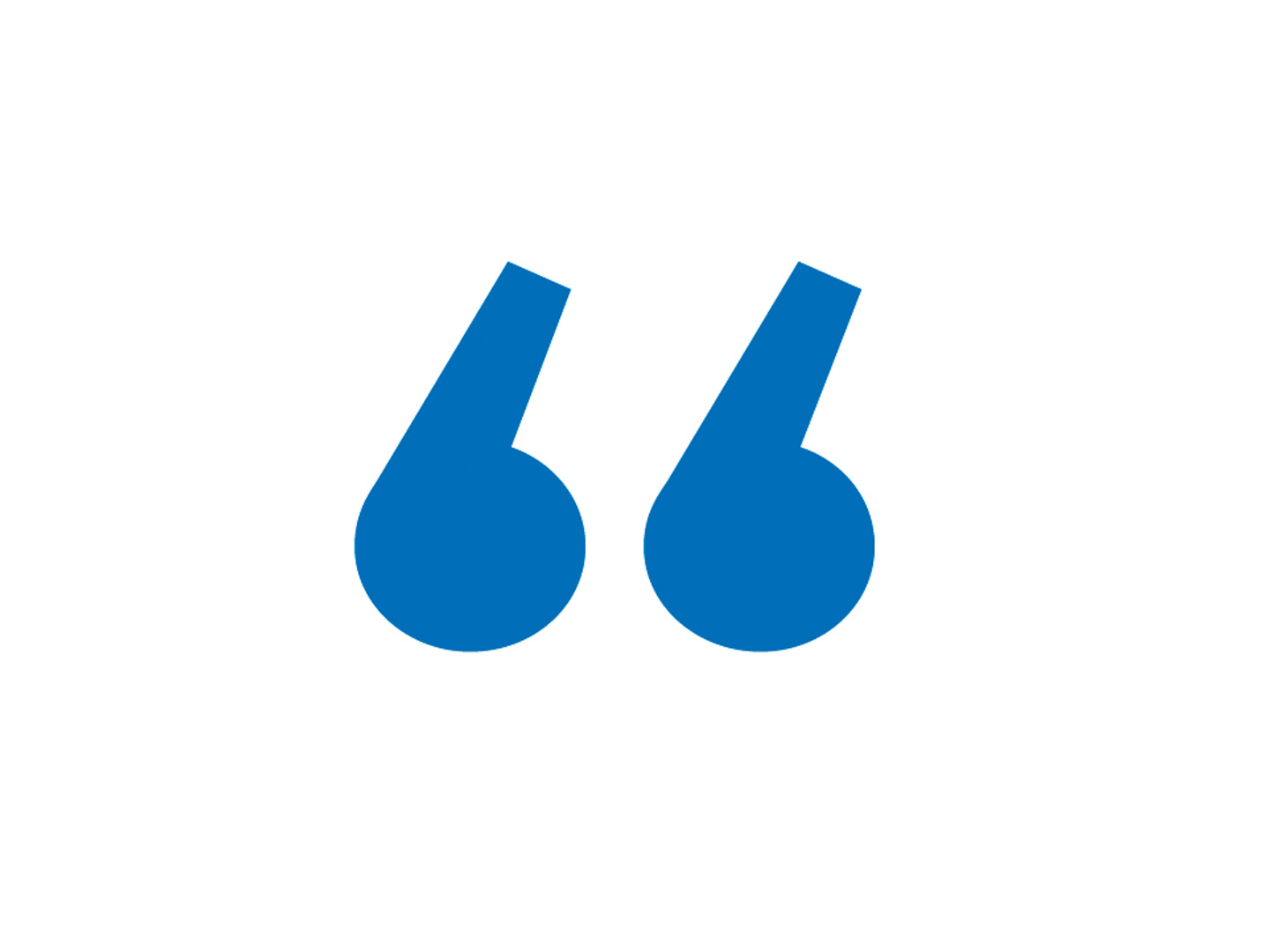
Our long-term goal is to provide simple, safe and reliable solutions for our operators to achieve production targets highly efficiently and with excellent quality. Uhlmann will always be one of the first contacts for us on this path.
Albert Vallverdú, Manufacturing Director at Synthon Hispania
Synthon
Synthon is an international, science-centered pharmaceutical company specialized in developing and manufacturing high-quality generic and hybrid medicines for patients around the world. Synthon‘s innovative R&D and proven ability to manufacture and distribute high-quality pharmaceuticals position the company well for the future. Through its strategic partners, the company markets its products in more than 100 countries worldwide. 1,600 employees work for Synthon – among others at the headquarters in Nijmegen (Netherlands) or at the two production sites in Santiago de Chile (Chile) and Sant Boi (Spain). www.synthon.com
Key figures for the production site at Sant Boi near Barcelona
| Employees: | approx. 500 |
| Production and packaging lines: | 7 packaging lines |
| Max. capacities per annum: | 1.4 billion tablets, 1.3 billion capsules, 85 million blisters |
| Share of solid products in blister packs: | 90 % |
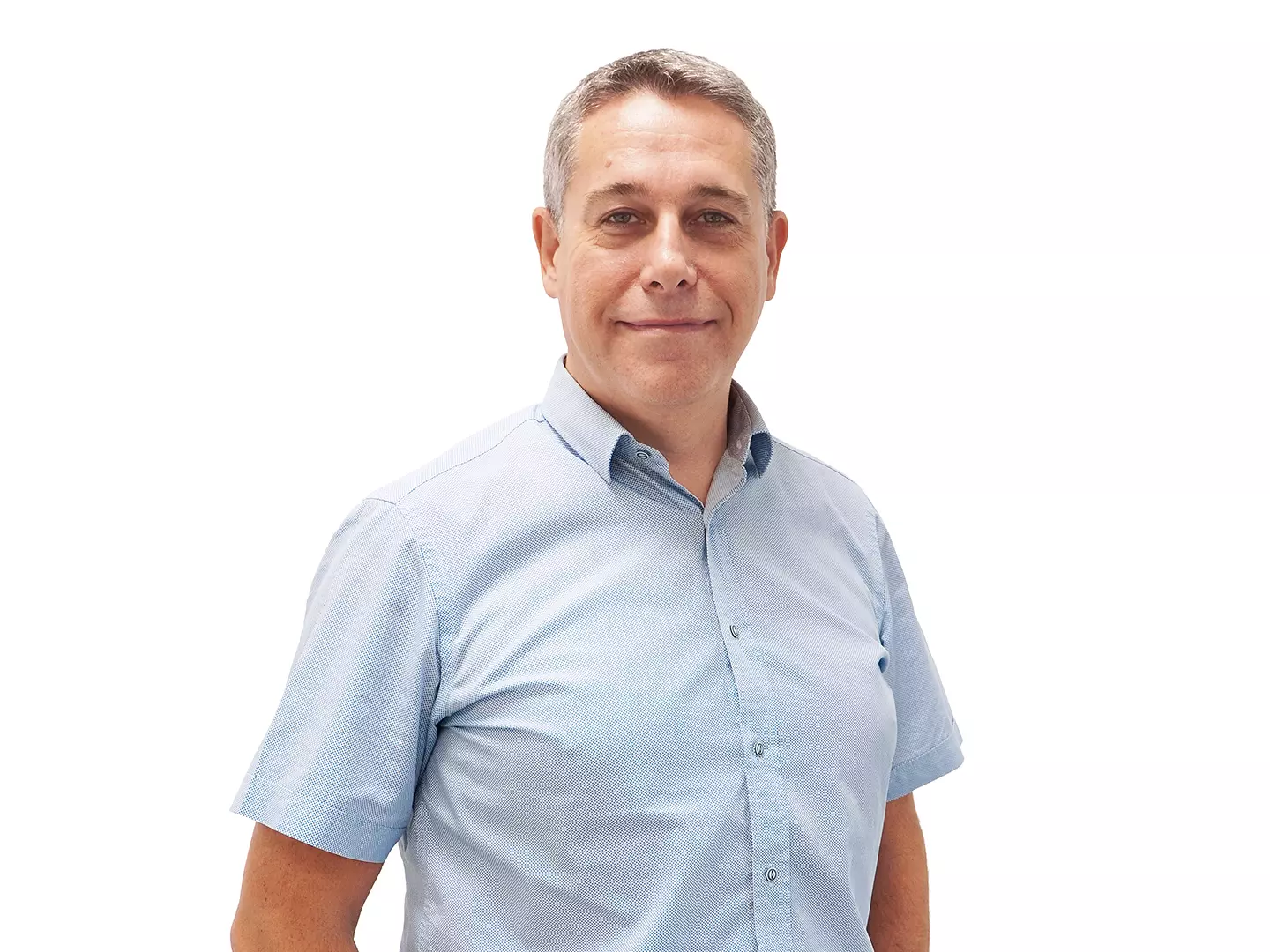
More a partner than a supplier
Manufacturing Director Albert Vallverdú talks in an interview about the new pharmaceutical packaging concept at Synthon and the cooperation with Uhlmann.
How did your new pharmaceutical packaging concept come about at the Sant Boi plant?
Albert Vallverdú: We took a close look at the topic of “small batches” and systematically identified all the factors that could have an impact on productivity.
Then we decided on a path that was unusual but promising – bundling our “small orders” on an additional blister line that has a particularly flexible transfer between blister machine and cartoner. Instead of packing the blisters directly into folding boxes, we can also store them temporarily in trays if required and box them in portions at a later stage. This special design was developed by Uhlmann especially for us.
For what reasons did you choose Uhlmann for the project?
In Sant Boi, two BEC 300 blister lines from Uhlmann have already been in operation since October 2017. Both management and operators are convinced by the robust, reliable, precise machines. In addition, we were able to make partial use of the existing format and spare parts for another BEC. Due to the similar design, only a short training session was needed onsite during commissioning to allow our production and technical teams to start up safely and quickly.
How did the collaboration go from yourpoint of view?
It was a very special project for both sides, based on the very good, trusting relationship between the two companies. We were in close contact with Uhlmann Ibérica, but also with the project team in Laupheim. The most interesting part for us was the joint development of the special solution, which we believe is crucial for the success of the project. Here, Uhlmann’s knowledge has helped us to solve some important challenges. Even before this, we viewed Uhlmann less as a supplier and more as a partner. This impression has been further reinforced.
Issue 09/2022: 75 batches a month on one line
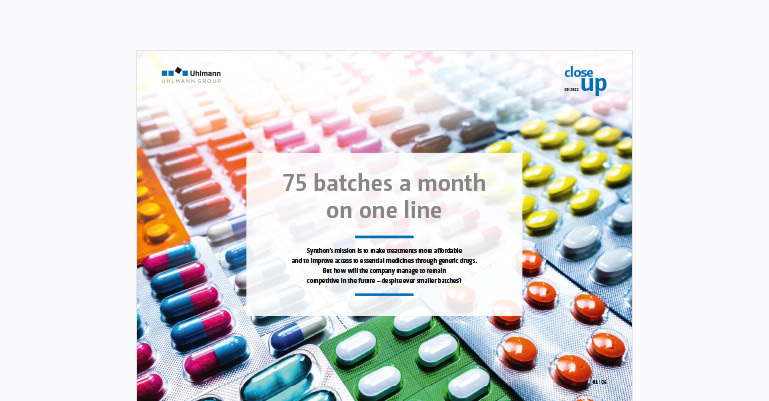


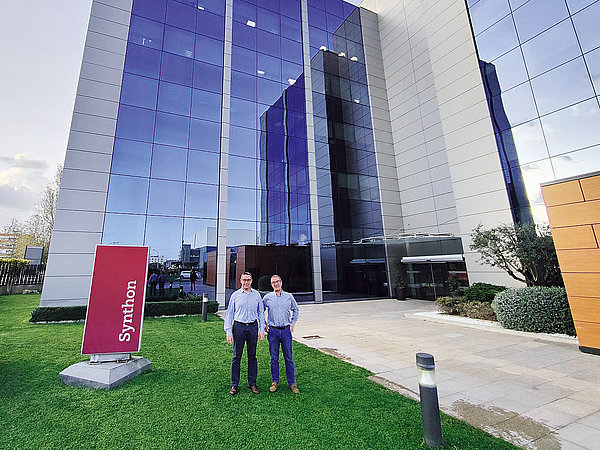
![[Translate to 中国人:] [Translate to 中国人:]](/fileadmin/Redakteure_Mainpage/01_Products/03_Blister_lines/05_BEC_200/BEC200_lateral_white.jpg)
![[Translate to 中国人:] [Translate to 中国人:]](/fileadmin/Redakteure_Mainpage/01_Products/01_Blister_machines/11_B_200/01_ANSICHT_Blistermaschinen_B200.jpg)
![[Translate to 中国人:] [Translate to 中国人:]](/fileadmin/Redakteure_Mainpage/01_Products/02_Cartoners/02_C_2155/01_C2155_P1_pfeil_blau_ret_neu.jpg)
![[Translate to 中国人:] [Translate to 中国人:]](/fileadmin/Redakteure_Mainpage/01_Products/06_Feeders/05_SimTap_feeder/UHL_Feeders_B1440c_SimTap4_1920x770.jpg)
![[Translate to 中国人:] [Translate to 中国人:]](/fileadmin/Redakteure_Mainpage/01_Products/06_Feeders/04_Vibratory_feeder/UHL_Feeders_B1440c_Vibrationszufuehrung_1920x770.jpg)
![[Translate to 中国人:] [Translate to 中国人:]](/fileadmin/Redakteure_Mainpage/01_Products/06_Feeders/03_Brush_box_feeder/UHL_Feeders_B1440c_Einbuerstzufuehrung_HM_1920x770.jpg)